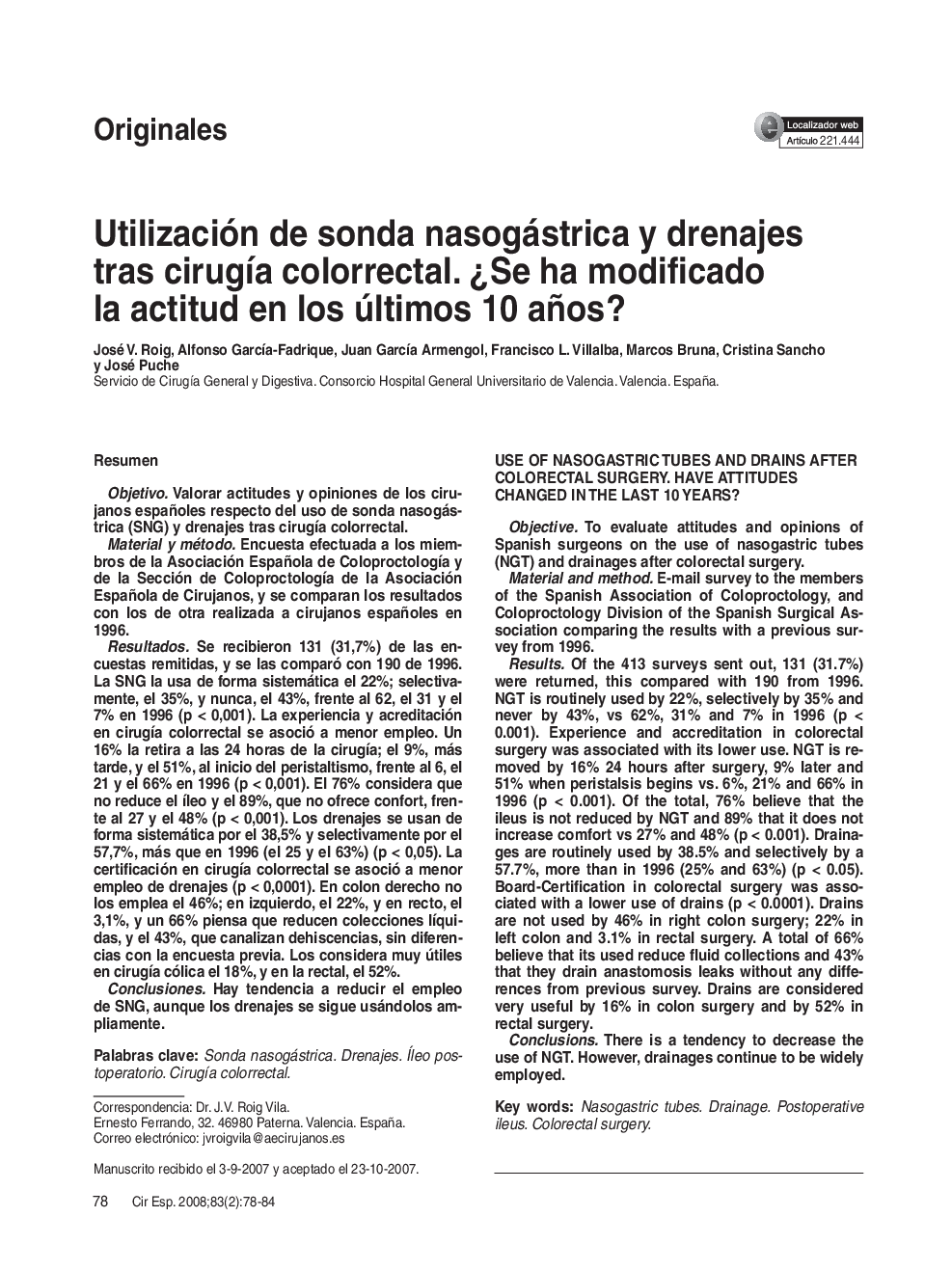| کد مقاله | کد نشریه | سال انتشار | مقاله انگلیسی | نسخه تمام متن |
|---|---|---|---|---|
| 4253575 | 1284283 | 2008 | 7 صفحه PDF | دانلود رایگان |

ResumenObjetivoValorar actitudes y opiniones de los cirujanos españoles respecto del uso de sonda nasogástrica (SNG) y drenajes tras cirugía colorrectal.Material y métodoEncuesta efectuada a los miembros de la Asociación Española de Coloproctología y de la Sección de Coloproctología de la Asociación Española de Cirujanos, y se comparan los resultados con los de otra realizada a cirujanos españoles en 1996.ResultadosSe recibieron 131 (31,7%) de las encuestas remitidas, y se las comparó con 190 de 1996. La SNG la usa de forma sistemática el 22%; selectivamente, el 35%, y nunca, el 43%, frente al 62, el 31 y el 7% en 1996 (p < 0,001). La experiencia y acreditación en cirugía colorrectal se asoció a menor empleo. Un 16% la retira a las 24 horas de la cirugía; el 9%, más tarde, y el 51%, al inicio del peristaltismo, frente al 6, el 21 y el 66% en 1996 (p < 0,001). El 76% considera que no reduce el íleo y el 89%, que no ofrece confort, frente al 27 y el 48% (p < 0,001). Los drenajes se usan de forma sistemática por el 38,5% y selectivamente por el 57,7%, más que en 1996 (el 25 y el 63%) (p < 0,05). La certificación en cirugía colorrectal se asoció a menor empleo de drenajes (p < 0,0001). En colon derecho no los emplea el 46%; en izquierdo, el 22%, y en recto, el 3,1%, y un 66% piensa que reducen colecciones líquidas, y el 43%, que canalizan dehiscencias, sin diferencias con la encuesta previa. Los considera muy útiles en cirugía cólica el 18%, y en la rectal, el 52%.ConclusionesHay tendencia a reducir el empleo de SNG, aunque los drenajes se sigue usándolos ampliamente.
ObjectiveTo evaluate attitudes and opinions of Spanish surgeons on the use of nasogastric tubes (NGT) and drainages after colorectal surgery.Material and methodE-mail survey to the members of the Spanish Association of Coloproctology, and Coloproctology Division of the Spanish Surgical Association comparing the results with a previous survey from 1996.ResultsOf the 413 surveys sent out, 131 (31.7%) were returned, this compared with 190 from 1996. NGT is routinely used by 22%, selectively by 35% and never by 43%, vs 62%, 31% and 7% in 1996 (p < 0.001). Experience and accreditation in colorectal surgery was associated with its lower use. NGT is removed by 16% 24 hours after surgery, 9% later and 51% when peristalsis begins vs. 6%, 21% and 66% in 1996 (p < 0.001). Of the total, 76% believe that the ileus is not reduced by NGT and 89% that it does not increase comfort vs 27% and 48% (p < 0.001). Drainages are routinely used by 38.5% and selectively by a 57.7%, more than in 1996 (25% and 63%) (p < 0.05). Board-Certification in colorectal surgery was associated with a lower use of drains (p < 0.0001). Drains are not used by 46% in right colon surgery; 22% in left colon and 3.1% in rectal surgery. A total of 66% believe that its used reduce fluid collections and 43% that they drain anastomosis leaks without any differences from previous survey. Drains are considered very useful by 16% in colon surgery and by 52% in rectal surgery.ConclusionsThere is a tendency to decrease the use of NGT. However, drainages continue to be widely employed.
Journal: Cirugía Española - Volume 83, Issue 2, February 2008, Pages 78–84